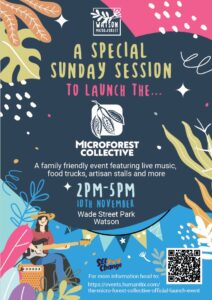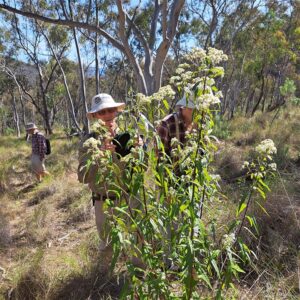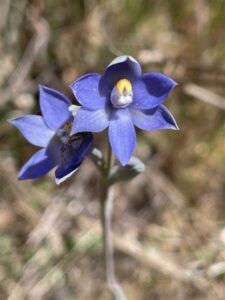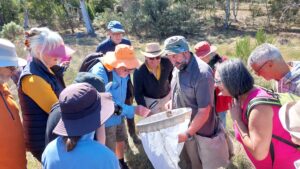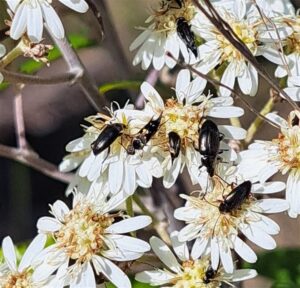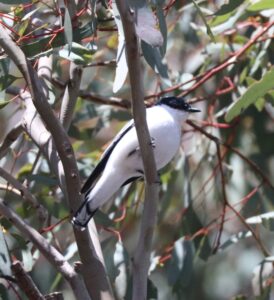Winter and now spring have been low rainfall seasons, and this has had an impact on the vegetation and wildlife in the reserve, with small dams drying out, and new plantings needing to be watered. As always there are still weeds thriving and FoMM is active in tackling the worst invasive species in our endangered grassy woodland areas, working with the Office of Nature Conservation in improving biodiversity at the Fair, and organizing events to share the beauty of Mount Majura with the community. Read the reports and join in events in November – you will be most welcome!
Working with Woody Weeds on Sunday 17 November 9 am – noon
What: We will be tackling woody weeds to remove Briar Rose and other weeds near the gully running next to Valour Park.
Where: Meet at the entrance to the nature reserve at Tay and Ian Nicol Streets, North Watson.
Wear clothes which cover your limbs and sturdy shoes; bring drinking water, sunscreen and garden gloves if you have them. We provide tools and gloves and a delicious homemade cake for morning tea. No experience necessary – all welcome.
There will be a short demo and briefing at the start so please aim to be there at 9 am.
More information and a map of the meeting point at https://majura.org.
Reports on Activities
Intrepid Landcare Event at The Fair on 10 October
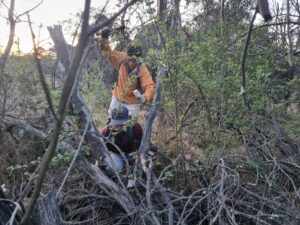 Two ANU Intrepid Landcarers attack large briar roses along the gully in the reserve near Valour Park. Photo courtesy of Intrepid Landcare.facebook.
Two ANU Intrepid Landcarers attack large briar roses along the gully in the reserve near Valour Park. Photo courtesy of Intrepid Landcare.facebook.
Sixteen students from ANU Intrepid Landcare group put aside their end of year pressures and deadlines to spend time at twilight working with FoMM on a lovely evening in the first week of daylight saving. Intrepid Landcare connects young people to work in groups caring for the environment. The ANU group took out many Briar Roses growing in the north-western part of The Fair, before ending the evening enjoying shared snacks. A great evening for enhancing wellbeing and improving the grassy woodlands at The Fair.
Wildflower Walk 13 October
Two Friends of Mount Majura, Max and Harriette, look at a Snowy Daisy Bush Olearia lirata growing not far from a track through the bush near the Blue Metal Road.
Ecologist Michael Doherty led a group of about 30 people from the Hackett gate along tracks in the grassy woodland and up the slope along the Casuarina track and across to the Blue Metal Road sharing with us information about the vegetation, the tree species and the wildflowers. An added bonus was sighting reptiles: Shinglebacks, a dragon and an Eastern Brown Snake Pseudonaja textilis crossing the Blue Metal Road between two sections of our group. Brown Snakes are very active at this time – here is a video to make you wary; thank you Phil.
There were a great variety of flowers in bloom, egg and bacon pea flowers of several types, other legumes like the pink flowering shrub Indigofera australis and some smaller purple flowering ones, Daphne Heath Brachyloma daphnoides with clusters of tiny white flowers, Native Flax Linum marginale with clear blue flowers, also blue flowers on the shrubby Nodding Blue Lily Stypandra glauca, and yellow flowers of Bulbine lilies. It has not been a great year for orchids, too dry over winter and spring, so many bulbous plants have remained dormant, but there were some Waxlip Orchids between the native grass tussocks in one of the better areas. And there were more flowers I haven’t named here; some in the group were using the updated Plant Species List with 355 native species now on the list. See the separate story on the Update to the Flora List here.
One of the new species on the updates list is the Short-leaf Sun Orchid, with a spider hiding in the shade in the lower flower. Photo by JaneR, courtesy of CanberraNatureMapr.
Monday@The Fair October Planting
The Office of Nature Conservation ONC team brought trays of forbs (herbaceous plants) that had been grown at Greening Australia for planting in the three seed nodes, in both burnt and unburnt areas. The dry conditions made hole digging difficult, water crystals were added to the holes and the new plants were watered. Some of these plants were not planted deeply enough and the root balls dried out; survival rates will need to be assessed.
More plants have been planted in guards closer to Clancy’s track and in a gully where Damon Bassett and helpers have done a lot of weeding, including tackling Sweet Vernal Grass (SVG) Anthoxanthum odoratum. In the gully area hand weeding of the flowering SVG is necessary as herbicide can damage the wildlife as well as the target weeds. In another dense patch of SVG discovered and mapped by Waltraud away from the gully, she is using herbicide to kill it. In the gully where SVG has been pulled out, the Monday@The Fair group planted fifty Carex appressa Tall Sedge seedlings. These have been left unguarded, as it is hoped that the rabbits will not find them attractive.
A Management Plan for the Wider Fair
Unfortunately, it seems SVG has had to be added to the list of the three evil grasses – Serrated Tussock, Chilean Needle Grass, African Lovegrass which, along with St John’s Wort, are the main target weeds listed in the Weed Management Plan 2024-29 for The Fair project site and the wider surrounds. The management plan has been prepared by Damon B, ONC, and will guide activities and actions of FoMM volunteers, Parks and Conservation Service rangers and contractors over the next few months. Mapping and monitoring the responses to weed control actions are crucial to assess success and to adapt the management of these invasive species.
Spider Walk 26 October
In the week before the walk, Stuart Harris found this Venus Peacock Spider Maratus hesperus on Mount Majura. Photo courtesy of CanberraNatureMapr.
October and November are when you are most likely to spot a peacock spider as the males are displaying their colours while sitting in a slightly raised spot. In Canberra they are usually on top of leaf litter or up a grass stem, usually in a warm sunny position in open bushland. (They occupy almost any habitat in Australia, including sandy places). These jumping spiders are all less than 5mm long (very small) and could be anywhere in bushland which hasn’t been burnt in many years. It takes patience, persistence, practice, and sharp eyes and a bit of luck to find a peacock spider.
We were very lucky to have the very knowledgeable and enthusiastic Stuart Harris, (of Peacock Spider fame, https://youtu.be/dKgZ0ziRyow ), lead fifteen people on a spider hunt. He brought an entomological net to sweep through clumps of grass,which clearly illustrated how many spiders were in the grass, gave us a good opportunity to photograph a Maratus and other spiders and was a rare opportunity to see small spiders up close which everyone appreciated. There were a lot of striped lynx spiders (grass spiders) with spiny legs, and various other small spiders, including an immature male Maratus hesperus.
Stuart’s infectious enthusiasm has inspired many of us, and I know at least some of the participants are teaching their children / grandchildren how to hunt for peacock spiders.
The group on the Saturday walk were all keen to see what Stuart has in the sweepnet. Photo by Phil Jones.
Pollinators
Pintail Beetles, Mordellidae (family), swarming to the pollen on the Snowy Daisy Bush flowers. Photo by Barbara Read snapped on the Wildflower Walk, courtesy of CanberraNatureMapr.
Last year from October through to March this year some of us participated in a survey of pollinators across 48 sites in and around Canberra as part of the Canberra Urban Biodiversity Surveys CUBS organized by the Office of Nature Conservation and using the resources of CanberraNatureMapr.
The survey was successful but is not funded to be repeated this year. A pity because it is a very different season so a comparison would have been useful.
Citizen scientists, that is anyone who wants to, can participate in monitoring pollinators on flowers for 2 minute periods during Australian Pollinator Week, from 9-17 November. Find out how at this website. Does require a bit of training in identifying insects – videos for training are on thewebsite.
To check out what is happening in the ACT go tothe ACT for Bees website.
Bird Flu – Know What to Do
When, not if, H5N1 avian influenza arrives in Australia its impact will be devastating to wild birds as well as to poultry. In the past two years it has killed millions of wild birds and tens of thousands of mammals around the world, where it has spread to all continents except Australia. It is highly likely to arrive here this spring in infected shorebirds, migrants from the northern hemisphere. Locally,we have the Latham’s Snipe Gallinago hardwickii, a shorebird that breeds in Japan and Russia and spends the southern spring and summer in eastern Australian wetlands. It is an example of a vulnerable species which could be impacted. H5N1 is one threat to our wildlife which we cannot avoid.
BirdlifeAustralia website has information on what to look for and what to do if you see sick or dead birds.
And for information on Latham’s Snipe see the documentary by Richard Snashell released by the Latham’sSnipe Project. It features ecologist Lori Gould and volunteer citizen scientists, including both young and old.
A vulnerable white-winged triller Lalage tricolor photographed by Brian Grinter on 20 September near the Fair. How many more species will become vulnerable when H5N1 arrives?
Birdos – Help Fill in the Gaps on the Mount Majura Map
CanberraNatureMapr is keen to improve the coverage of bird sightings in reserves so they can develop a Canberra Woodland Bird Quality Index Map.
Here is the gap map where they would like surveys done. Not all the gaps are in steep inaccessible country… so on your next birding wander, try somewhere new! Instructions on ways to do the survey are here.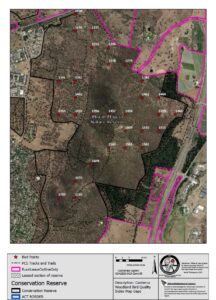
Map of survey points on Mount Majura where currently there are gaps in birdsighting data. Can you help fill the gaps?
Exhibitions, Events
For women, see the Women in Nature Wellspring Events – they are free,
Past Issues hosted by Landcare, and there is one on 2 November at Bluetts Block, followed by several more later in the month at different locations.
For other Festival of Nature events in November organized under the Landcare ACT umbrella, see their festival page.
Catch the Waterhouse Natural Science Art Prize before it closes on 10 November. Its free at the Australian Archives. Parking is also free if you go on a weekend. Check the café opening times … it closes early in the afternoon.
Webinar: Powerful Pollinators
10 November at noon. Find out more and register at this webpage.
Local Native Plant Sale at Greening Australia
Missed out on the earlier sale days? This is your chance! Go along to GA’s final plant sale for the year and choose from a range of local native wildflowers, grasses, shrubs and trees.
WHEN: SATURDAY 16 November, 10am – 2.30pm
WHERE: Greening Australia, 1 Kubura Place, Aranda ACT
PRICES: $66 for a tray of 20 native tubestock, $33 for 10. Mix and match species as you like. Payment is by CARD ONLY.
Webinar: Fixing our Nature Laws
The Conservation Council ACT Region is discussing new legislation needed both federally and in the ACT on Tuesday 3 December, 6:30pm – 8pm. See this site for more information.